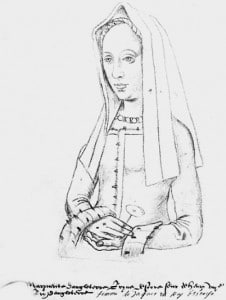 Today we have part two of a series of three articles on Margaret Tudor by Heather R. Darsie. Thank you to Heather for writing these wonderful articles. Click here to read Part I.
Today we have part two of a series of three articles on Margaret Tudor by Heather R. Darsie. Thank you to Heather for writing these wonderful articles. Click here to read Part I.
In celebration of Margaret Tudor’s marriages – first to King James IV of Scotland on 8 August 1503 and then to Archibald Douglas, 6th Earl of Angus, on 6 August 1514 – we are going to take a look at the three phases of Margaret’s life, continuing today with her time as Queen of Scots.
The marriage of James IV, the Thistle, and Margaret Tudor, the Rose, was an attempt by Henry VII to bring peace to the bordering countries. Their marriage was celebrated by the poet William Dunbar, resident of James IV’s court, through his poem, “Thistle and the Rose”:
The merle [blackbird] scho [she]sang, ‘Haill, Roiss of most delyt,
Haill, of all flouris quene and soverane,’
The lark scho song, ‘Haill, Rois, both reid and quhyt [white],
Most plesand flour, of michty cullouris twane;’
The nychtingaill song, ‘Haill, naturis suffragene [representative],
In bewty, nurtour and every nobilness,
In riche array, renown, and gentilness.
The marriage of Queen Margaret facilitated peace between Scotland and England throughout the rest of her father’s life.
Margaret was crowned Queen of Scots at Edinburgh in March 1504. Margaret did not give birth to any children until 1507. Thereafter, Margaret gave birth to James, Duke of Rothesay, in 1507; a daughter in 1508; and Arthur Stewart, Duke of Rothesay, in 1509. Sadly, none of Margaret’s first three children survived infancy. It would be two-and-a-half years before Margaret would have another child. In April 1512, Margaret welcomed the future James V into the world. Their second daughter was born later in 1512 and passed away shortly after birth. Finally, Alexander Stewart, Duke of Ross, was born in 1514 but also died in infancy. However, Margaret continued to enjoy a caring relationship with James IV, of whom Erasmus commented that “[James IV] had wonderful powers of mind, an astonishing knowledge of everything, an unconquerable magnanimity and the most abundant generosity.”
The Scotland Queen Margaret knew was Catholic. Some of Martin Luther’s ideas had begun to trickle into the country. The Chepman and Myllar press was founded in Edinburgh in 1508 due to the patronage of James IV. A Catholic breviary, or priest’s handbook, printed by the Chepman and Myllar press exists to this day, showing that at least some form of religious text was being disseminated throughout Scotland while Margaret was queen.
James IV also renovated several palaces, including Stirling, Edinburgh and Linlithgow. Queen Margaret lived at these different castles throughout her time as queen consort. Margaret’s husband was known to speak English, Gaelic, German and other western European languages. Like Margaret, he could also speak French and Latin. Latin was an international language, much like English is today. One must wonder if Margaret and James IV shared any letters or conversations in French or Latin, like Margaret’s brother was known to do with his infamous brunette mistress.
Henry VII kept up his end of the bargain for the Treaty of Peace, which was signed by Henry VII and James IV in 1502 and included the marriage of Margaret and James IV as a term. When Queen Margaret’s younger brother Henry became king of England upon the death of Henry VII in 1509, the young man had little concern for maintaining international peace and waged war upon France. Scotland and France were allies all the way back to 1295, when the Auld Alliance was constructed through the mutual interests of France and Scotland to keep aggressive England at bay. Henry VIII also declared lordship over Scotland, which was a direct affront to James IV. In 1513, Scotland declared war on England in an attempt to divert the English campaign in France. After a bevy of letters between Henry VIII, James IV and Pope Leo X, James IV sent his Scottish navy to the assistance of France in summer 1513. In response, Leo X ordered the excommunication of James IV. James raised an army of approximately 30,000 men and set out to invade England.
Queen Margaret and King James IV had been residing at Linlithgow Palace when James IV and the vast Scottish army marched into battle. In what must have been a tense and devastating time, Queen Margaret awaited news of her husband while she cared for her eighteen-month-old son. Sadly, James IV was killed on September 9, 1513, at the infamous Battle of Flodden, also known as the Battle of Branxton, which took place near the village of Branxton in Northumberland, England. Queen Margaret had been bitterly opposed to the war from the start. Now, her toddler son was the new king of Scotland.
Today’s posts on the Tudor Society are:
Sources and Suggested Reading
Picture: A sketch of Princess Margaret Tudor of England. Sixteenth-century drawing in the Recueil d’Arras (Arras, Bibliothèque municipale, Ms. 266)
- Hanson, Marilee. Margaret Tudor Queen of Scotland Facts, Biography & Information. http://englishhistory.net/tudor/relative/margaret-tudor/ Retrieved 13 August 2015.
- Macdougall, N., The Stewart Dynasty in Scotland, James IV, (Tuckwell press, 1997).
- Ryrie, A., The Origins of the Scottish Reformation (Manchester: Manchester University Press, 2006).
- Margaret Tudor. http://www.undiscoveredscotland.co.uk/usbiography/t/margarettudor.html Retrieved 13 August 2015.
- 5. Lenz, Harvey Nancy. The Rose and the Thorn: The Lives of Mary and Margaret Tudor, Macmillan (1975).
- Tasioulas, J. A., ed. The Makars, Caongate (1999).
- Marshall, Rosalind K. Scottish Queens. Tuckwell Press (2003).
- Margaret Tudor, Queen of Scotland. Luminarium: Encyclopedia Project. http://www.luminarium.org/encyclopedia/margarettudor.htm Retrieved 13 August 2015.
- James IV (r. 1488-1513). The Official Website of the British Monarchy. http://www.royal.gov.uk/HistoryoftheMonarchy/Scottish%20Monarchs(400ad-1603)/TheStewarts/JamesIV.aspx Retrieved 13 August 2015.